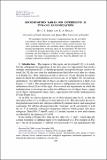Files in this item
Decomposition tables for experiments. II. Two–one randomizations
Item metadata
| dc.contributor.author | Brien, C. J. | |
| dc.contributor.author | Bailey, Rosemary Anne | |
| dc.date.accessioned | 2013-04-15T14:01:04Z | |
| dc.date.available | 2013-04-15T14:01:04Z | |
| dc.date.issued | 2010-10 | |
| dc.identifier | 49887485 | |
| dc.identifier | 416d7305-624b-49bb-a235-b4e476da1091 | |
| dc.identifier | 000282402800018 | |
| dc.identifier | 77957575510 | |
| dc.identifier.citation | Brien , C J & Bailey , R A 2010 , ' Decomposition tables for experiments. II. Two–one randomizations ' , Annals of Statistics , vol. 38 , no. 5 , pp. 3164-3190 . https://doi.org/10.1214/09-AOS785 | en |
| dc.identifier.issn | 0090-5364 | |
| dc.identifier.other | ORCID: /0000-0002-8990-2099/work/39600090 | |
| dc.identifier.uri | https://hdl.handle.net/10023/3479 | |
| dc.description.abstract | We investigate structure for pairs of randomizations that do not follow each other in a chain. These are unrandomized-inclusive, independent, coincident or double randomizations. This involves taking several structures that satisfy particular relations and combining them to form the appropriate orthogonal decomposition of the data space for the experiment. We show how to establish the decomposition table giving the sources of variation, their relationships and their degrees of freedom, so that competing designs can be evaluated. This leads to recommendations for when the different types of multiple randomization should be used. | |
| dc.format.extent | 27 | |
| dc.format.extent | 661837 | |
| dc.language.iso | eng | |
| dc.relation.ispartof | Annals of Statistics | en |
| dc.subject | Analysis of variance | en |
| dc.subject | Balance | en |
| dc.subject | Decomposition table | en |
| dc.subject | Design of experiments | en |
| dc.subject | Efficiency factor | en |
| dc.subject | Intertier interaction | en |
| dc.subject | Multiphase experiments | en |
| dc.subject | Multitiered experiments | en |
| dc.subject | Orthogonal decomposition | en |
| dc.subject | Pseudofactor | en |
| dc.subject | Structure | en |
| dc.subject | Tier | en |
| dc.subject | QA Mathematics | en |
| dc.subject.lcc | QA | en |
| dc.title | Decomposition tables for experiments. II. Two–one randomizations | en |
| dc.type | Journal article | en |
| dc.contributor.institution | University of St Andrews. Statistics | en |
| dc.contributor.institution | University of St Andrews. Centre for Interdisciplinary Research in Computational Algebra | en |
| dc.identifier.doi | 10.1214/09-AOS785 | |
| dc.description.status | Peer reviewed | en |
This item appears in the following Collection(s)
Items in the St Andrews Research Repository are protected by copyright, with all rights reserved, unless otherwise indicated.

